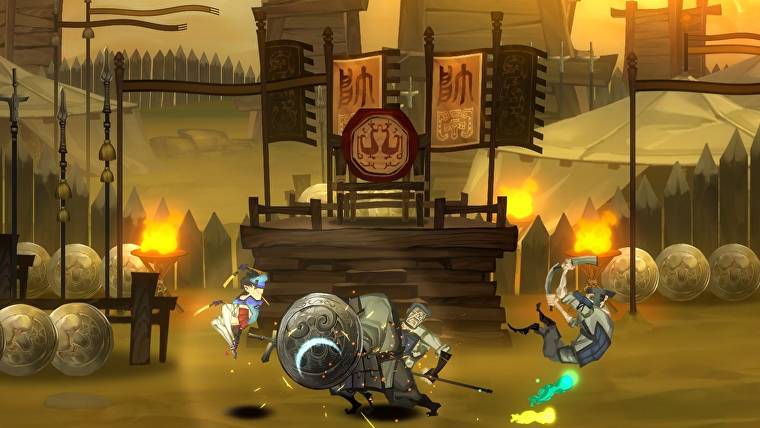Vanillaware might make great games but what players mostly think of is the art style. Beyond the highly stylized look are good quality games that make great use of the medium and concept. This is the first thing I think of when I look at Bladed Fury. The interesting look and stylized design make it fascinating to simply explore. Add in some intense battles, action gameplay and it is very similar to the Muramasa, though of course this is centered around Chinese culture compared to that being Japanese, that Vanillaware made some time back. With a different company approaching the same concept, will they find the same success or will they be known as a less popular clone?
Bladed Fury has a pretty straightforward story that tries to do more with a simple concept. You play a princess, simply named Ji, who is tricked into killing her father and, as a result, exiled. After this unjust chain of events, including your older sister being held at the capitol, Ji sets off to find justice and with the power of the gods, might just be successful.

After the exposition dump, most of the story is told through events or optional dialogue sections that do less to explain your quest but rather, focus on worldbuilding. Now you know why you’re killing that undead warrior or weird creature, though it really isn’t much to get people invested. Once you get past the midway point it just becomes a question of how many more people need to die before you reach the end. Assuming you have the skills to get there.
On paper, Bladed Fury is shockingly simple. There are two weapons, a few defensive moves, and a handful of summons. For most peons, any combo will defeat them, though yellow-colored enemies have a shield that requires a more measured approach with a heavy weapon. Outside of this, most peons can be steamrolled unless they have huge hitboxes or overwhelm you, both of which may or may not happen. Naturally, the centerpiece is the boss battles, which are at best a mixed bag.

Initially, bosses feel well balanced and fun. There is a clear indicator of when they’re going to attack and you can learn what needs to be done either through common sense or gauging the action. As players progress, bosses start to change in both design and approach, neither of which are exactly favorable.
Where one of the first bosses is very predictable, has attacks that can be thrown back at him for an easy stun, and moves relatively little, some of the other enemies just want to punish. For example, there is one boss that can hit almost every corner of the screen and the only way I’ve found to consistently avoid taking damage is to jump and then dodge backward. It sounds simple, though with attacks going both straight and angled, it requires a focused mind and determination to avoid. Some of the later bosses add more moves as the fight progresses and many of them are a massive departure from the core gameplay loop.
Where Ji can effortlessly dispatch peons, bosses insist on defense over offense. It also doesn’t help players really need to know what’s coming or they will take damage. If this isn’t bad enough, later on, bosses disregard certain concepts and just start attacking a field. The final boss has large sweeping attacks and mechanic heavy blows that are tricky to dodge and easy to mess up. Thankfully, even on normal Bladed Fury is somewhat forgiving, though it’s the type of design that might destroy a newcomer someone with experience won’t have that issue.

In addition to strong bosses, Bladed Fury doesn’t allow for a lot of diversity. The only customizable element, summons known as soul silver, have distinct uses and most time side with four of the six. For example, Zixu Wu is great for pulling enemies towards Ji to do damage but there aren’t many situations where you’ll need that or outright damage isn’t better. On the other end, Jiang Wen, slows enemies, something that almost feels broken against bosses. With no planning or direction, I was able to deal with about a sixth of the final boss’s health just slowing him down and dodging one attack. By contrast, Bogu does a single shot that does about half that, so not only is it less, Jiang Wen can be used twice. Even one of the earlier skills, Youji Yang, does a little less than Bogu, though evens it out by having three uses. However, in the grand scheme of things, using Bogu for instant guaranteed damage, over making sure the boss doesn’t move and gets hit by every arrow Youji Yang shoots, is a better play and naturally Jiang Wen beats both.
Where Bladed Fury excels isn’t story or gameplay, it’s designed. Every level feels unique, the bosses stand out and everything is so exciting. Backgrounds are lush, characters have a distinct design and there is a lot of variance between locations. Sometimes it’s a hellish landscape and other times it’s a castle dominated by skeletons and spiders. This makes the adventure easier to go through because the art is just so good.
Bladed Fury Review – Verdict
Bladed Fury certainly has some flaws, be it extremely linear levels, arguably cheap bosses, and short (about four hours, though it can easily be done in two), but it isn’t a bad experience. The art and design are interesting enough to suck players in and not let go, with bosses at least offering an engaging experience. It would be nice to see more depth or additional play styles but the base game is at least fun.
[Editor’s Note: Bladed Fury was reviewed on PlayStation 5 and a copy was provided to us by the publisher for review purposes.]
